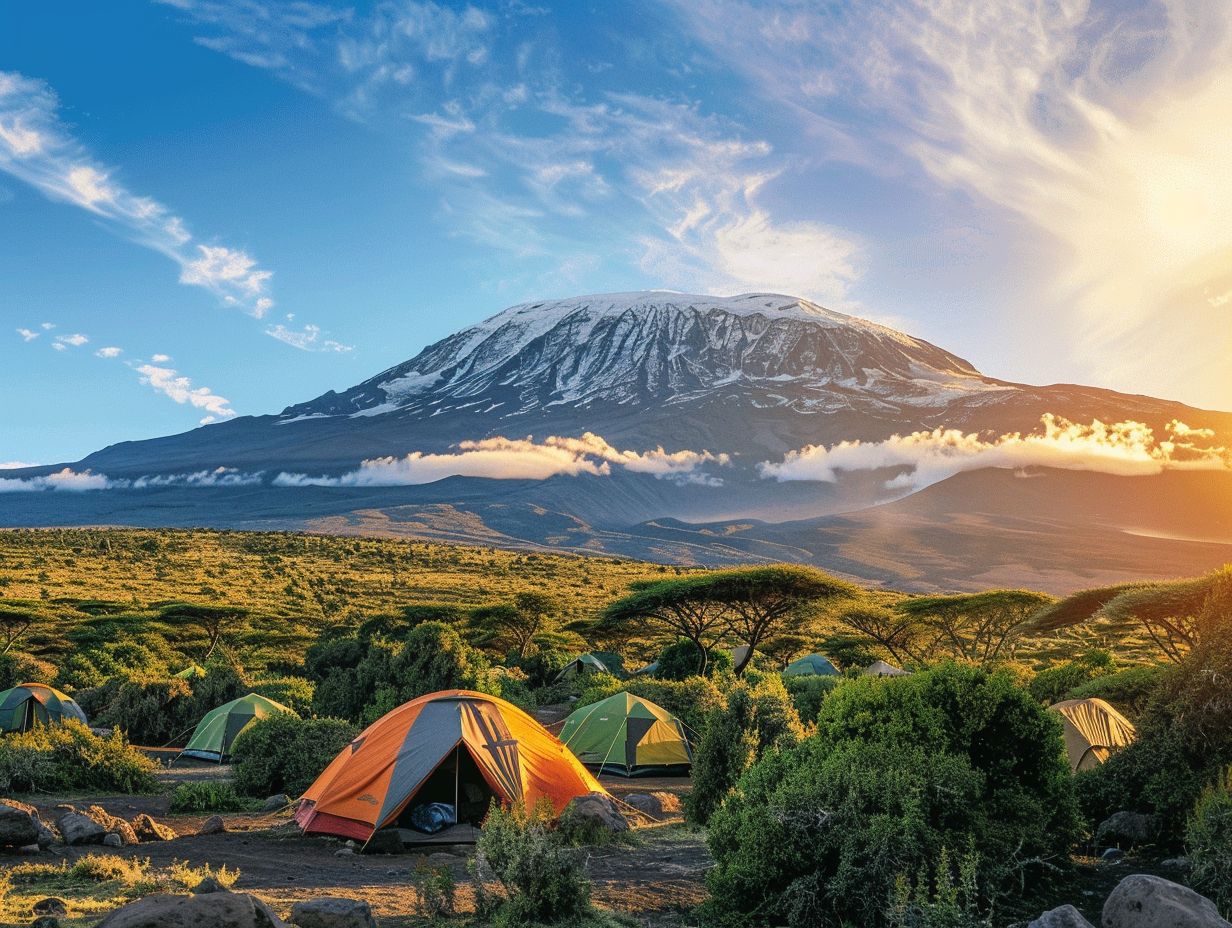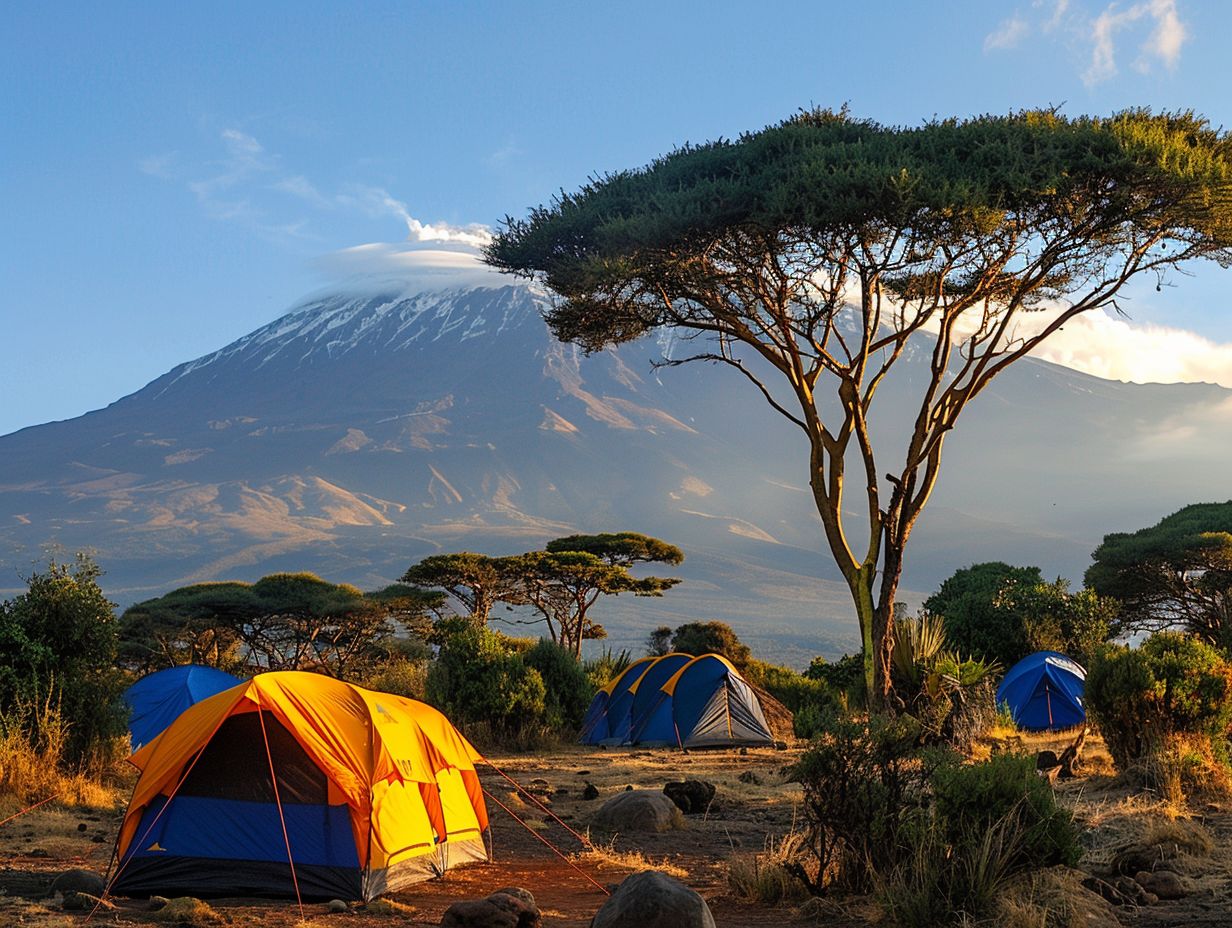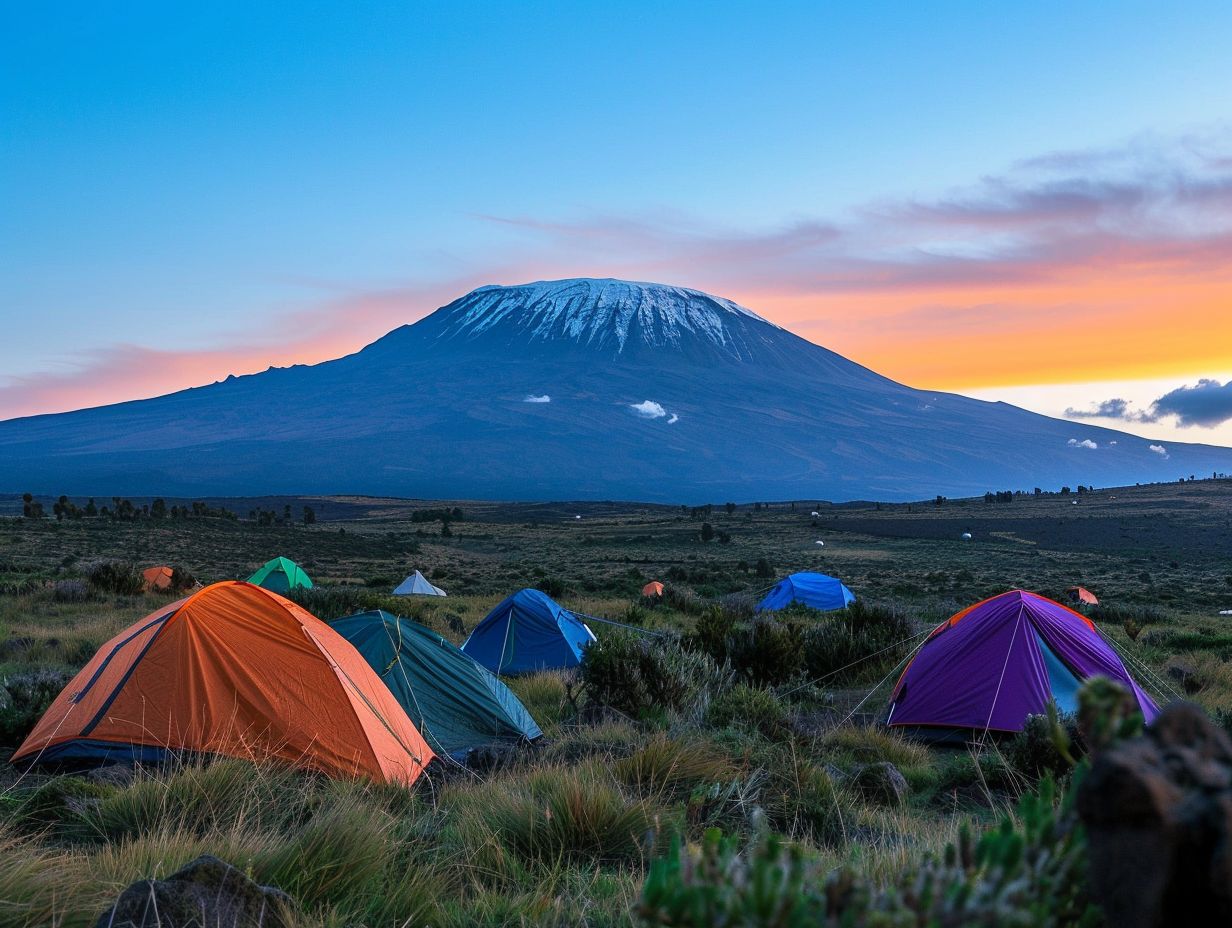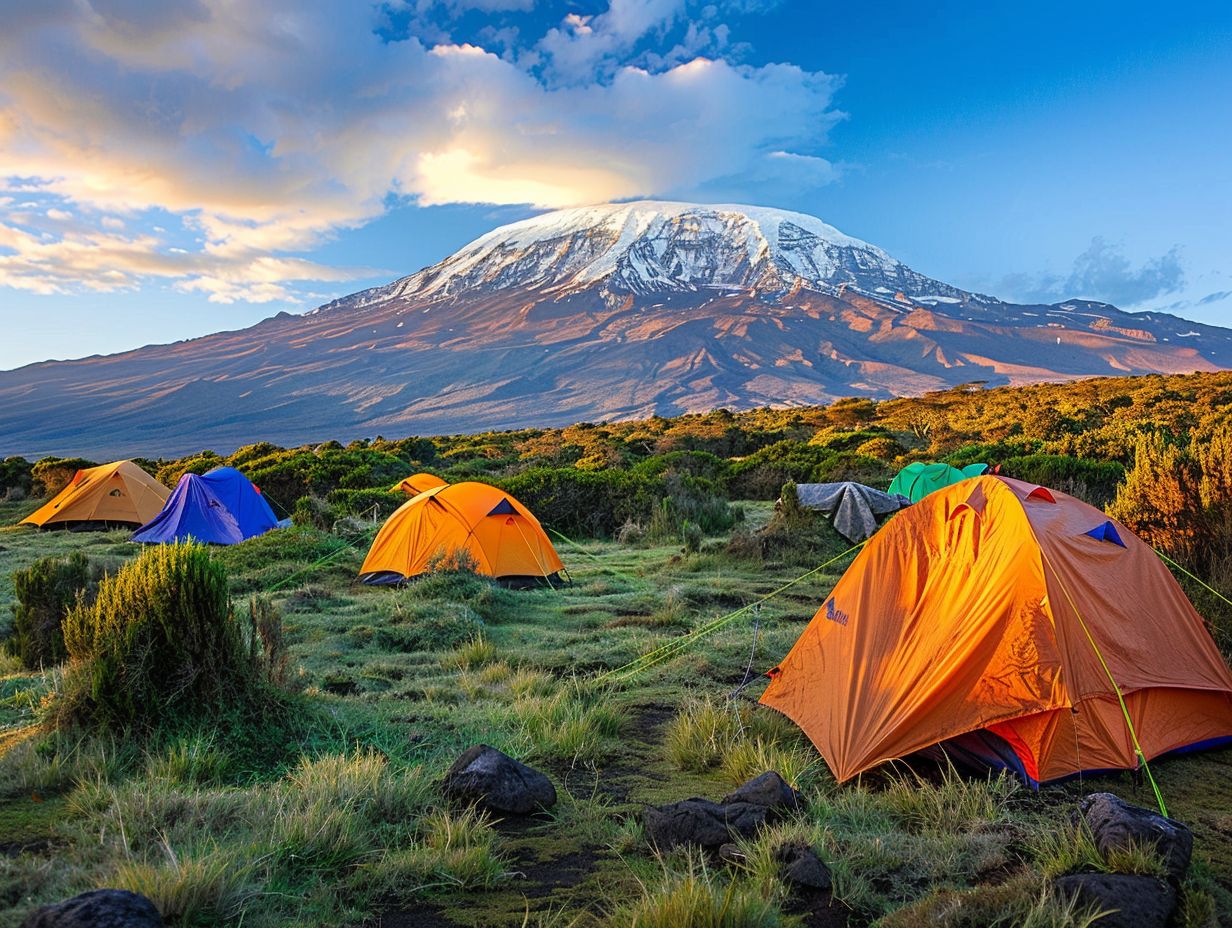
Kilimanjaro Campsites
Are you planning to conquer Mount Kilimanjaro but unsure about the best route to take or the ideal campsite to stay at? Look no further!
We explore the different routes to summit Kilimanjaro, the top campsites on the mountain, the facilities available at these campsites, and the challenges you may face while camping on Kilimanjaro.
From altitude sickness to weather conditions, we provide you with all the information you need for a successful trek. Let’s dive in!
Key Takeaways:

- The Machame and Lemosho routes offer the best campsites for a scenic and comfortable trek up Kilimanjaro.
- Basic facilities such as accommodations, toilets, and dining areas are available at all campsites, providing a comfortable camping experience on the mountain.
- Camping on Mount Kilimanjaro comes with challenges, including altitude sickness, unpredictable weather, and physical demands, making it important to properly prepare and acclimatize before attempting the climb.
What are the Different Routes to Summit Kilimanjaro?
Mount Kilimanjaro offers multiple routes for climbers to reach its summit, each with its unique challenges and landscapes.
One of the most popular routes is the Machame route, also known as the “Whiskey Route.” This route is known for its scenic beauty and diverse landscapes, including lush rainforests, moorlands, and alpine deserts. The Machame route is considered a challenging but rewarding climb, suitable for climbers with a good level of fitness and some hiking experience.
Another well-known route is the Marangu route, often called the “Coca-Cola Route.” This route is preferred by many due to its gradual ascent and comfortable hut accommodations along the way.
-
Marangu Route:
The Marangu Route, also known as the Coca-Cola Route, is one of the most popular paths up Kilimanjaro due to its gradual ascent and comfortable sleeping huts. It provides a scenic journey through diverse landscapes, offering a unique camping experience with designated campsites.
The Marangu Route stands out for its well-maintained sleeping huts, offering a more comfortable alternative to traditional camping. Positioned strategically along the trail, these huts provide shelter, bedding, and communal dining areas.
The terrain on this route is relatively gentle, making it suitable for trekkers of various skill levels. Hikers can enjoy stunning views of Kilimanjaro’s landscapes, from lush rainforests to alpine meadows. The route boasts amenities such as clean water sources and basic toilet facilities, enhancing the overall trekking experience.
-
Machame Route:
The Machame Route, known as the Whiskey Route, is a challenging path that attracts climbers seeking a more adventurous experience. With tent camping along the way, climbers need to be prepared for changing weather conditions and focus on proper acclimatization.
The Machame Route is favored by many climbers due to its stunning scenery, diverse vegetation, and the opportunity to experience multiple ecosystems within a relatively short period. While navigating through rocky terrain and lush rainforests, climbers are immersed in the beauty of the Kilimanjaro landscape.
For those embarking on this journey, it is essential to have the right equipment, including sturdy hiking boots, warm clothing for cold nights, and a reliable sleeping bag. The route offers various campsites for overnight stays, each strategically located to aid in the acclimatization process.
-
Lemosho Route:
The Lemosho Route is known for its scenic beauty and diverse terrain, offering a longer itinerary to aid in acclimatization. Porters support climbers by carrying gear and setting up camps, ensuring a comfortable journey with hearty meals and ample rest stops.
There are various meal provisions along the route, with warm and nourishing dishes prepared by skilled cooks. The mountainous challenges present in the route offer a thrilling yet demanding experience, requiring climbers to traverse through different landscapes like rainforests and alpine deserts.
Opportunities for rest and relaxation are strategically placed along the path, allowing climbers to rejuvenate amidst the breathtaking views. Campsites are carefully selected to provide both comfort and safety, making the journey not only adventurous but also memorable.
-
Rongai Route:
The Rongai Route, originating from the north side of Kilimanjaro, is a less crowded path offering a sense of wilderness. With health checks at the gate and a focus on gradual acclimatization, climbers can enjoy a serene journey along well-defined paths.
What sets the Rongai Route apart is its unique gate procedures, where climbers are briefed on the journey ahead and undergo thorough health assessments to ensure a safe ascent.
The route’s emphasis on gradual acclimatization plays a pivotal role in preventing altitude sickness, allowing climbers to adapt comfortably to the increasing elevation. As trekkers traverse through diverse landscapes, from lush forests to alpine deserts, the tranquility of the path envelops them, providing a peaceful ambiance amidst nature’s grandeur.
-
Umbwe Route:
The Umbwe Route is one of the steepest and most direct paths to Kilimanjaro’s summit, requiring climbers to acclimatize quickly. With fewer stops and a rapid descent, climbers are challenged to maintain oxygen saturation levels while camping at high altitudes.
Climbers embarking on the Umbwe Route must be prepared for the strenuous ascent, characterized by steep, rocky terrain that demands a high level of physical fitness and determination.
This challenging trail offers breathtaking views of Kilimanjaro’s untouched beauty, but it requires careful management of energy and oxygen levels. As climbers reach higher elevations, the air thins, making it crucial to acclimatize properly to prevent altitude sickness. Descending the route can be equally demanding, with the steep descent putting pressure on knees and ankles.
What are the Best Campsites on Mount Kilimanjaro?

Mount Kilimanjaro boasts several outstanding campsites that cater to climbers’ needs, providing essential facilities, breathtaking views, and comfortable accommodations amidst the challenging terrain.
One of the most popular campsites on Kilimanjaro is Machame Camp, situated at an elevation of around 3,000 meters. This campsite offers stunning panoramic views of the surrounding landscape, including the lush rainforest below. Campers can rest in sturdy tents and enjoy hearty meals prepared by experienced cooks.
Another sought-after option is Barranco Camp, located in a picturesque valley at approximately 3,950 meters. This campsite provides a serene atmosphere amidst towering cliffs, with the iconic Barranco Wall adding a touch of adventure to the landscape.
-
Mandara Hut:
Mandara Hut serves as the first overnight stop for climbers on the Marangu Route, offering basic amenities, warm meals, and health checks to ensure a smooth acclimatization process. Climbers can rest and refuel here before continuing their ascent.
Upon reaching the Mandara Hut, climbers are welcomed with hearty meals that not only satisfy hunger but also provide essential nutrients for the trek ahead. The hut’s staff conduct thorough health assessments to monitor climbers’ well-being and readiness for further ascent.
Beyond just a resting place, Mandara Hut acts as a hub for gear checks to ensure everyone is equipped properly for the challenges ahead. This time spent acclimatizing at this altitude significantly benefits climbers, increasing their chances of a successful summit bid.
-
Horombo Hut:
Horombo Hut, a vital resting point on several routes, offers essential facilities like toilets and water sources, ensuring climbers can rest, relax, and recuperate before continuing their journey. The hut provides comfortable sleeping arrangements amidst the mountain’s beauty.
Hygiene is paramount at Horombo Hut, with clean and well-maintained toilets that offer a sense of comfort and convenience to weary travelers. The availability of fresh water sources ensures climbers can stay hydrated and refreshed during their stay. Guests can also enjoy leisure time at the hut, taking in breathtaking views of the surrounding landscapes.
Regarding sleeping accommodations, Horombo Hut goes above and beyond, providing cozy beds and warm blankets to ensure a good night’s rest after a challenging day of trekking. Whether you choose a private room or a dormitory, comfort is guaranteed at this mountain refuge.
-
Kibo Hut:
Kibo Hut, located near the summit, offers dining areas for climbers to refuel before their summit climb. With a focus on acclimatization, climbers can rest and prepare their gear for the challenging final ascent to Kilimanjaro’s peak.
Surrounded by breathtaking views of the glaciers and rugged terrain, Kibo Hut provides a crucial resting point for trekkers attempting to conquer Mount Kilimanjaro. The dining options at Kibo Hut cater to the varied dietary needs of climbers, ensuring they are well-nourished for the rigorous journey ahead.
As climbers spend time at Kibo Hut, they engage in acclimatization techniques to adjust their bodies to the altitude, reducing the risk of altitude sickness during their climb. This strategic approach enhances their chances of reaching the summit successfully.
Gearing up at Kibo Hut is a meticulous process, with climbers meticulously checking and organizing their equipment to ensure they are adequately prepared for the unforgiving conditions awaiting them at higher altitudes.
The tranquility and beauty of Kibo Hut serve as a motivating factor, inspiring climbers to push forward and conquer the challenges that lie ahead on their quest to summit the majestic Kilimanjaro.
-
Barafu Hut:
Barafu Hut, the base camp for the summit climb, provides climbers with essential briefings, acclimatization time, and insights into the terrain ahead. It serves as a pivotal point before the challenging ascent to Kilimanjaro’s summit.
Located at an impressive 4,673 meters (15,331 feet) above sea level, Barafu Hut offers climbers a panoramic view of the majestic landscapes and a final opportunity to prepare mentally and physically for the arduous journey ahead. Climbers are often briefed on the final push to Uhuru Peak, the highest point of Kilimanjaro, and reminded of the importance of pacing oneself and staying hydrated.
Acclimatization protocols become even more critical at this altitude as climbers adjust to the thin air and frigid temperatures. Many climbers use this time to rest, hydrate, and eat well-balanced meals to ensure their bodies are primed for the summit attempt.
-
Mweka Camp:
Mweka Camp marks the descent point for climbers after summiting Kilimanjaro, offering scheduled departure times, descent guidance, and necessary services for a safe journey down the mountain. Climbers can reflect on their achievement and prepare for the return.
Upon reaching Mweka Camp, climbers are advised to adhere to the set departure times to maintain the descent schedule. The camp provides vital instructions on the descent procedures, ensuring climbers are well-informed and equipped for the journey ahead. Climbers can collect their equipment, including any rented gear, before starting the descent. The support services at the camp encompass assistance with packing, organizing belongings, and addressing any post-summit queries, fostering a smooth transition from the summit triumph to the trek back.
What are the Facilities Available at the Campsites?
The campsites on Mount Kilimanjaro offer a range of essential facilities to ensure climbers’ comfort and safety during their trek. From accommodations and dining areas to toilets and water sources, these sites cater to various needs of the climbers.
Accommodations at Kilimanjaro’s campsites vary from basic tents to more deluxe options with sleeping bags provided for a comfortable night’s rest. Hygiene amenities include clean toilet facilities that are eco-friendly, promoting responsible trekking practices.
The dining areas offer a selection of nutritious meals to refuel climbers after a day of hiking. Water provisions are carefully monitored to ensure climbers have access to safe drinking water, crucial for staying hydrated at high altitudes.
-
Accommodations:

Accommodations on Kilimanjaro range from basic huts to tents, providing climbers with shelter and rest during their ascent. Climbers are advised to bring suitable gear, including camp shoes, for a comfortable stay at the campsites.
While huts offer a more solid structure and some amenities, such as beds or mattresses, tents provide a more immersive outdoor experience for those seeking a closer connection to nature. Climbers often opt for tents to enjoy the night sky and sounds of the mountain wilderness. Choosing between huts and tents depends on personal preferences and the level of comfort desired during the climb.
Appropriate gear, like camp shoes, is crucial for ensuring a successful climb. Camp shoes should be lightweight, durable, and comfortable to wear around the campsites after a long day of trekking. They provide relief to tired feet and allow climbers to relax and recover for the next day’s challenges.
-
Toilets:
Toilets at Kilimanjaro’s campsites are crucial for maintaining hygiene and health standards among climbers. Regular checks ensure the cleanliness and functionality of the facilities throughout the trek.
These facilities play a vital role in ensuring the well-being of trekkers by providing a safe and sanitary environment for relieving themselves amidst the challenging terrain.
Proper sanitation practices are imperative to prevent the spread of diseases and preserve the delicate ecosystem of the mountain.
By having well-maintained toilets, climbers can focus on their ascent without worrying about health risks associated with unsanitary conditions.
-
Water Sources:
Water sources at the campsites on Kilimanjaro play a vital role in keeping climbers hydrated and energized throughout their trek. The purity and accessibility of these sources are crucial for climbers’ well-being.
At each campsite, water sources vary in terms of quality and quantity. Some camps have natural springs providing fresh, clean water, while others rely on stored water that may need purification.
It is essential for climbers to consume enough water to prevent altitude sickness and maintain energy levels. Access to these sources is paramount, ensuring climbers can easily fill their bottles and hydration packs before continuing their ascent. Without reliable access to clean water, climbers may face dehydration or waterborne illnesses, jeopardizing their trekking experience.
-
Dining Areas:
Dining areas at Kilimanjaro’s campsites offer climbers nutritious meals to sustain their energy and replenish vital nutrients. Scheduled meal times ensure climbers are well-fed and prepared for the trek ahead.
Every campsite on Kilimanjaro provides a welcoming dining tent or area where climbers can gather to enjoy hearty meals prepared by experienced cooks.
A typical day starts with a nourishing breakfast spread, fueling climbers for their day’s adventure. Throughout the ascent, hikers can refuel at lunch break with energizing dishes. The evening meals often feature a combination of carbohydrates, proteins, and fresh vegetables, catering to the nutritional needs of climbers. This balanced diet is crucial for maintaining stamina and supporting acclimatization, key elements for a successful climb to the summit.
What are the Challenges of Camping on Mount Kilimanjaro?
Camping on Mount Kilimanjaro presents climbers with various challenges, including altitude sickness risks, unpredictable weather conditions, and demanding physical exertion. Overcoming these obstacles requires proper preparation and acclimatization strategies.
At high altitudes, the thin air can lead to altitude sickness, with symptoms ranging from mild headaches to potentially life-threatening conditions like pulmonary edema or cerebral edema.
The ever-changing weather on Kilimanjaro can shift from scorching sun to freezing winds in a matter of hours, challenging even seasoned climbers. The physical demands of trekking through steep terrains and extreme conditions can quickly exhaust even the fittest individuals. To combat these challenges, climbers must focus on gradual acclimatization, proper hydration, nutrition, and adequate rest.
-
Altitude Sickness:
Altitude sickness, a common challenge on Kilimanjaro, can affect climbers due to reduced oxygen levels at higher elevations. Monitoring health through pulse oximeter readings and proper acclimatization techniques help mitigate the risks.
Altitude sickness, also known as acute mountain sickness, can manifest in various ways, such as headache, nausea, fatigue, and shortness of breath. Climbers should be vigilant about these symptoms as they ascend to higher altitudes, especially above 8,000 feet. Regular check-ups with a medical professional and thorough oxygen saturation monitoring are crucial preventative measures to identify and address any health concerns promptly.
In addition, gradual ascent and acclimatization are key strategies to reduce the likelihood of altitude sickness. Climbers should aim to increase their elevation gradually, incorporate rest days into their itinerary, and stay properly hydrated to help their bodies adjust to the thinner air and lower oxygen levels.
-
Weather Conditions:
Weather conditions on Kilimanjaro are unpredictable and can range from scorching sun to freezing temperatures. Climbers must be prepared with appropriate gear and clothing to adapt to the changing climate patterns.
At lower altitudes, trekkers may encounter hot and humid conditions, whereas higher up, temperatures can plummet below freezing, even in the height of summer. Packing layered clothing is essential to accommodate these extreme shifts.
Adequate protection against both UV radiation and chill is vital. Sudden rain showers are not uncommon, necessitating waterproof clothing and reliable footwear. Proper hydration is crucial in combating altitude-related challenges, so carrying ample water and snacks is advisable.
-
Physical Demands:

The physical demands of climbing Kilimanjaro are strenuous, requiring climbers to be in good physical condition and prepared for extended exertion. Adequate rest, proper acclimatization, and mental endurance are essential to overcome the challenges posed by the mountain.
Fitness requirements play a crucial role in preparing for the ascent of Kilimanjaro. Cardiovascular endurance, strength training, and flexibility are key components of a comprehensive training regimen. Climbers often incorporate hiking and uphill walking to simulate the uphill climbs they will face.
Taking sufficient rest intervals during the trek is vital to prevent overexertion and allow the body to recover. Acclimatization to the altitude is a gradual process that helps the body adjust to the lower oxygen levels at higher altitudes, reducing the risk of altitude sickness. Strategies such as slow ascent, hydration, and proper nutrition can aid in managing the demanding trek successfully.
Frequently Asked Questions:
1. What are the different campsites on Mount Kilimanjaro?
A: There are a total of 10 campsites on Mount Kilimanjaro, which are Machame, Shira, Lemosho, Barranco, Karanga, Barafu, Mweka, Umbwe, Rongai, and Horombo.
2. Do I need to book campsites in advance for Mount Kilimanjaro?
A: Yes, it is recommended to book campsites in advance as they can get fully booked, especially during peak climbing season. This will ensure that you have a guaranteed spot at the desired campsite.
3. What are the facilities available at Kilimanjaro campsites?
A: The facilities available at Kilimanjaro campsites vary, but generally include basic amenities such as tents, toilets, and cooking areas. Some campsites may also have dining halls and shower facilities.
4. Are there any age restrictions for staying at Kilimanjaro campsites?
A: Yes, there is a minimum age requirement of 10 years old for staying at Kilimanjaro campsites. This is for safety reasons and to ensure that climbers are physically capable of completing the trek.
5. Can I bring my own tent to Kilimanjaro campsites?
A: Yes, you can bring your own tent to Kilimanjaro campsites. However, it is important to note that the campsite fees include the use of tents, so bringing your own may not be necessary.
6. Are there any rules or regulations for staying at Kilimanjaro campsites?
A: Yes, there are rules and regulations that climbers must follow when staying at Kilimanjaro campsites. These include proper disposal of waste, respecting other climbers, and following the instructions of the guides. It is important to adhere to these rules for the safety and preservation of the mountain.